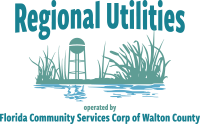Save water. Save money.

Grab a wrench!
Grab a wrench and fix that leaky faucet. It’s simple, inexpensive, and can save 140 gallons a week.
- Repair dripping faucets and leaky toilets. Dripping faucets can waste about 2,000 gallons of water each year. Leaky toilets can waste as much as 200 gallons each day.
-
Turn off the water while you brush your teeth and save 4 gallons of water a minute (more than 100 gallons of water a week).
- Wash your produce in the sink or a pan that is partially filled with water instead of running water from the tap.
-
If you accidentally drop ice cubes when filling your glass from the freezer, don’t throw them in the sink, drop them in a house plant instead.
- Designate one glass for your drinking water each day. This will cut down on the number of times you run your dishwasher.
- Soak your pots and pans instead of letting the water run while you scrape them clean.
-
Don’t use running water to thaw food.

$20 can save 22 per minute!
Conventional shower heads can provide more water than needed by delivering 5 to 8 gallons of water per minute (gpm).
- However, for less than $20, you can reduce your water use to 21/2 gpm or less by installing a low-flow shower head.
- This is a 25-75% savings without sacrificing the quality of your shower!
- To check the flow rate of your existing shower head, turn the shower on all the way and see how long it takes to fill a one -gallon plastic milk jug (you may have to cut a piece of the neck off the jug so it will fit over the shower head.), or a one -gallon bucket.
- If your shower head fills a one-gallon container in less than 15 seconds, it is using more than 4 gallons per minute of water.
- Make plans to replace high water use shower heads with more efficient high-performance models. There are many excellent shower heads on the market. Your local hardware or plumbing-supply store is a good source. When buying a shower head, be sure that it delivers no more than 2 1/2 gallons per minute; 1 1/2 to 2 gpm is even better.
- In the shower, turn the water on to get wet; turn it off to lather up; then back on to rinse off. Repeat when washing your hair.
- Time your shower to keep it under 5 minutes. You’ll save up to 1000 gallons a month.
- To save water and time, consider washing your face or brushing your teeth while you shower.
- Never pour water down the drain when there may be another use for it such as watering a plant or garden.
- Kitchen sink disposals require lots of water to operate properly.
- Try to do one thing each day that will result in saving water. Don’t worry if the savings are minimal — because every drop counts!

Consider buying High Efficiency!
A washing machine is the second largest water user in your home, with toilets being first.
- A traditional washing machine uses approximately 41 gallons per load.
- The best way to lower this usage is to buy a high efficiency washing machine.
- These machines use 35-50% less water and 50% less energy per load.
- No matter what kind of washing machine you have, here are some basic tips that can reduce water use for washing clothes:
- Operate the washer with full loads only – even if the machine has an adjustable load setting.
- A full load is the most efficient way to wash clothes.
- If your washer has a variable water volume setting, select the minimum amount required per load.
- Pre-treat stains to avoid rewashing.
- Use the shortest wash cycle for lightly soiled loads.
- When doing laundry, match the water level to the size of the load.
- While staying in a hotel or even at home, consider reusing your towels.
- Check your washing machine hoses regularly for cracks that could result in leaks.
- Choose new water saving appliances like washing machines that save up to 20 gallons per load.

Flush less and save!
Your toilet can flush up to 40% of the total water used in your home down the drain.
- Since 1994, only 1.6 gallon toilets are manufactured in the United States. This means that most new homes already have a low flow toilet. If your home is more than 5 years old, the chances are your toilet is using more water than necessary and could operate on a lot less. To lower the amount of water used for each flush, your need to displace water in the toilet tank.
- Place toilet dams in the tank. Toilet dams are placed towards the sides and around the flushing mechanisms of the tank. They hold back water and prevent it from leaving the tank. Dams can be purchased at your local hardware store.
- Use pop bottles or a plastic jug to displace the water in your tank so that there is less water flowing into the bowl. Fill the bottle with water or place rocks in the bottom of the container for weight. Choose a container that will best fit in the space in your toilet tank without interfering with the flushing mechanism.
- Avoid flushing the toilet unnecessarily. Dispose of tissues, insects and other similar waste in the trash, rather than the toilet.

The gang’s all here!
Bathe your young children together.
- Plug the bathtub before turning the water on, then adjust the temperature as the tub fills up.
- Teach your children to turn the faucets off tightly after each use.
- When adjusting water temperatures, instead of turning water flow up, try turning it down. If the water is too hot or cold, turn the offender down rather than increasing water flow to balance the temperature.

Run full loads only.
A typical dishwasher uses between 8 and 15 gallons per load of dishes with an average of about 9.3 gallons per load.
- Running a full load of dishes should save water over washing the same dishes by hand.
- Many newer dishwashers require little or no advance rinsing of dishes. Some manufacturers now offer high-efficiency dishwasher models. These dishwashers use less water and energy. A high-efficiency dishwasher can wash a load of dishes using 5 to 7 gallons of water.
- A family that replaces a 12-gallon per load machine with a 6-gallon per load machine and runs their dishwasher 4 times per week will save about 1,250 gallons of water per year. Take advantage of the conserving benefits of your dishwasher!

Stem the flow.
Use a hose nozzle when washing cars to save water.
- Use a broom, rather than a hose to clean sidewalks.
- Consider using a commercial car wash that recycles water. If you wash your own car, park on the grass to do so.
- When you give your pet fresh water, don’t throw the old water down the drain. Use it to water your trees or shrubs.
- When you clean your fish tank, use the water you’ve drained on your plants. The water is rich in nitrogen and phosphorus, providing you with a free and effective fertilizer.
- If you have a swimming pool, get a cover. You will cut the loss of water by evaporation up to 90%.

High water bill?
If your water bill is higher than usual – for no apparent reason – its time to do a little household investigating to see if you have a leak.
- Next, go outside and check the reading on your meter. After an hour, check the meter again. If it has not moved then there are no leaks. If is has, check each fixture, faucet and appliance, one by one. Be sure to also look for any telltale puddles or wet spots on floors or ceiling. A leak within a wall or under a floor, left unattended, could result in serious structural damage over a period of time. If you still can’t find the leak in the house you can step up your investigation and try to determine if a leak is outside the house.
- Then, make sure no one uses any water for at least an hour. That means do not use any sinks or faucets, inside or out, and no toilet flushing.
- First, turn off all appliances that use water such as washing machines, ice-makers, and faucets.
- First, you will need to turn the water off where it enters your home. Note the reading on the water meter and then take a break. Later, check the meter again and see if the reading has changed. If the reading has changed then you have found the leak. If it hasn’t, then you may need to call a plumber and have them determine if you have a leak.
- By taking a little time to get to the bottom of your rising water bill, you could save a lot of money.
- Know how to turn your water supply off at any time. This will save water and reduce the damage to your home.

Conserve and save.
Be aware of and follow all water-conservation and water-shortage rules and restrictions, which may be in effect in your area.
- Create an awareness of the need for water conservation among children.
- Start a compost pile as an alternate method of disposing of food waste, instead of using a garbage disposal. Garbage disposals also can add 50% to the volume of solids in septic tanks, which can lead to malfunctions and maintenance problems.
- Support efforts and programs that create a concern for water conservation among tourists and visitors to our state.
- Make sure your visitors understand the need for, and benefits of, water conservation.
 4432 US Hwy 98 E, Santa Rosa Beach, FL 32459 | Hours: M - F 8:00am - 4:30pm | Phone: 850-231-5114 | Fax: 850-231-4924
4432 US Hwy 98 E, Santa Rosa Beach, FL 32459 | Hours: M - F 8:00am - 4:30pm | Phone: 850-231-5114 | Fax: 850-231-4924 


